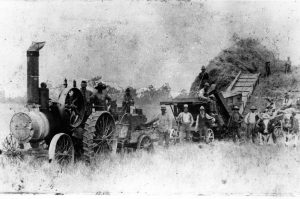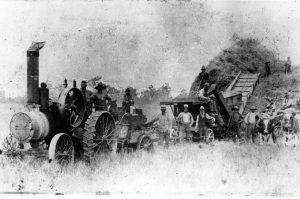Hay Camps Flourished in Late 1800s Along the Kankakee
The Stroller
By William Ormond Wallace
Just before the turn of the present century great prairie tracts on both sides of the Kankakee annually looked like circus lots.
There were tents, sheds, and shelters—with about 80 men and 20 horses—and masses of machinery. These were the Hay Camps.
John A. Morrison had the largest one. He had three big tents at Round Grove each fall. One was a commissary—and an office of sorts—one was the kitchen and mess tents, and one was a sleeping tent with almost 100 bunks in double tiers, each covered with a mosquito net.
There was also a blacksmith shop under a spreading white oak tree and two blacksmiths who were always busy keeping the various machines and equipment in order.
The work in the hay field was carefully balanced. Mowers, takers and stackers operating like a mechanical unit, kept pace with one another and coming in the rear were hayracks, each with four pitchers. Two haystacks made a load.
Morrison had hundreds of acres of hay land under lease in both Porter and Jasper counties. His crew put up 60 tons of hay a day, and within the three-month period from late July to Oct. 30 they put up 5,000 tons.
All through Porter County were scattered hay presses where custom baling was done. Baled hay was shipped by rail to Chicago, mostly to the Wells-Fargo barns. Unbaled hay in great broad racks was frequently hauled to the Hay Market in Chicago.
In 1895 the first automobile race, staged at Chicago, was the initial warning that perhaps the “horseless carriage” was here to stay, and from then on, the hay business began to slowly decline.
In 1897 a new town was started near Hobart It was called New Chicago and was intended to be a great industrial city. The factory that established the town was the “Electric Runabout” company, makers of a battery-driven horseless carriage equipped with Edison “submarine type” storage batteries.
In those days of veils, dusters and tied-down hats, this electric vehicle was definitely “an old ladies buggy.” It had easy side steps, a beautiful black coach body, and a lever steering-handle—and never went faster than 8 miles an hour.
Soon the Chicago parks and boulevards were traveled by the new Electric Carriage. However, there were not enough charging stations, and many a sweet old lady was stranded far from home—almost five miles away in some cases—and had to send for her coachman and the team to get her home.
The sudden burst of manufacturing activity collapsed overnight. The incoming gasoline vehicles didn’t want an electric competitor, and they magnified and exaggerated the danger of being stuck on a railroad crossing or a street intersection. But during the boom days of the new factory and the new town many hayfield workers quit the haying camps and hurried to the “big factory.”
By the time the new factory slipped into oblivion, the haying operations along the Kankakee were becoming less and less profitable, and many erstwhile field hands found no job awaiting them on their return. The Chicago Hay Market had fewer and fewer buyers, and the hay presses in Porter County were irregularly active.
The big hay camps continued a slowing existence until 1900, but an undiscoverable “hay poison.” which killed considerable stock, reduced the swamp-hay prestige.
Then there was an epidemic of rattlesnakes. In the Morrison camp alone 49 were killed in one week and an employee named Matt Kelly was bitten. The blacksmith cauterized the bite and Kelly recovered, but work was slowed down. The workers no longer rushed from stack lo stack to load the wagons. They paused to check for snakes.
Then, after a long dry spell during which the Kankakee was lowered from 8 to 11 inches, there were many prairie fires. Farmers and haying crews used back-firing and did what they could to stop the devastation, but frequently big haystacks were lost in spite of all their efforts.
Poisonous mildew, snakes, fires and the coming of the carriages all helped to bring hay camps into less profitable existence. The last one to shut down was Morrison’s 82-man organization at Round Grove, but for almost two decades hay camps were as noteworthy as canoe traveling, hunting, fishing and timber cutting on the Kankakee.
Those hay camps were models of efficiency. They were the first example of mass production. They were operated methodically and rapidly.
The hay presses took a definite share for baling. The commission men took a share, the pay roll took a share, and transportation took a fixed share. The cost per ton was fixed, and the profit was pretty well established at 30 percent, until the slow-down began.
The gas-burners soon began to edge ahead of the “hay burners.” Then came the Spanish-American War, which for a time took all the hay on the market. But after that conflict ended the doldrums were more extensive than before.
Like the outlaws, trappers, Indians and missionaries, the “hay makers” are now only individuals in history. And very few remember their one-time spectacular existence along the Kankakee in Porter County.




